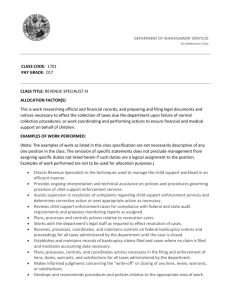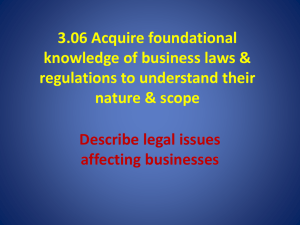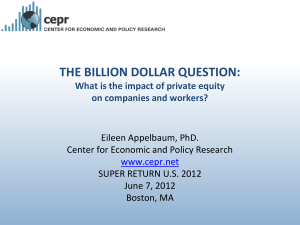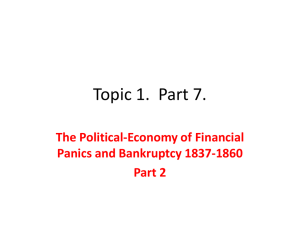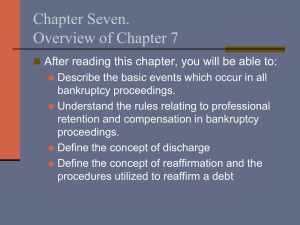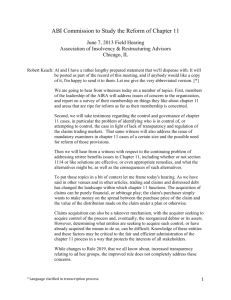Jonathan C. Lipson - ABI Commission to Study the Reform of
advertisement
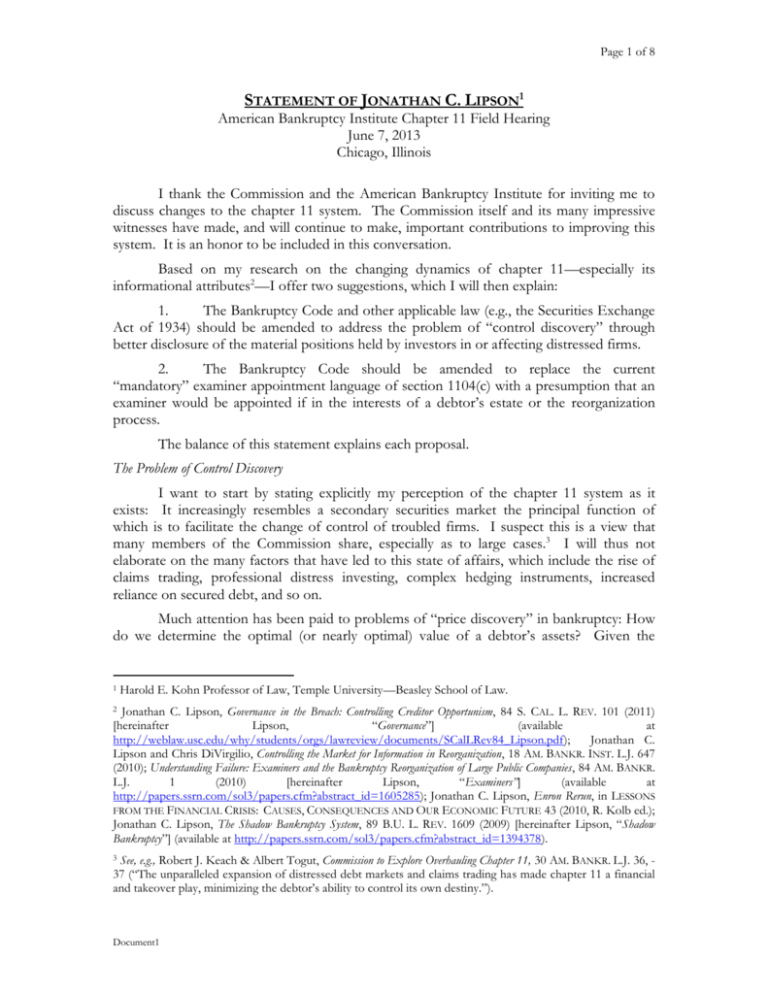
Page 1 of 8 STATEMENT OF JONATHAN C. LIPSON1 American Bankruptcy Institute Chapter 11 Field Hearing June 7, 2013 Chicago, Illinois I thank the Commission and the American Bankruptcy Institute for inviting me to discuss changes to the chapter 11 system. The Commission itself and its many impressive witnesses have made, and will continue to make, important contributions to improving this system. It is an honor to be included in this conversation. Based on my research on the changing dynamics of chapter 11—especially its informational attributes2—I offer two suggestions, which I will then explain: 1. The Bankruptcy Code and other applicable law (e.g., the Securities Exchange Act of 1934) should be amended to address the problem of “control discovery” through better disclosure of the material positions held by investors in or affecting distressed firms. 2. The Bankruptcy Code should be amended to replace the current “mandatory” examiner appointment language of section 1104(c) with a presumption that an examiner would be appointed if in the interests of a debtor’s estate or the reorganization process. The balance of this statement explains each proposal. The Problem of Control Discovery I want to start by stating explicitly my perception of the chapter 11 system as it exists: It increasingly resembles a secondary securities market the principal function of which is to facilitate the change of control of troubled firms. I suspect this is a view that many members of the Commission share, especially as to large cases.3 I will thus not elaborate on the many factors that have led to this state of affairs, which include the rise of claims trading, professional distress investing, complex hedging instruments, increased reliance on secured debt, and so on. Much attention has been paid to problems of “price discovery” in bankruptcy: How do we determine the optimal (or nearly optimal) value of a debtor’s assets? Given the 1 Harold E. Kohn Professor of Law, Temple University—Beasley School of Law. Jonathan C. Lipson, Governance in the Breach: Controlling Creditor Opportunism, 84 S. CAL. L. REV. 101 (2011) [hereinafter Lipson, “Governance”] (available at http://weblaw.usc.edu/why/students/orgs/lawreview/documents/SCalLRev84_Lipson.pdf); Jonathan C. Lipson and Chris DiVirgilio, Controlling the Market for Information in Reorganization, 18 AM. BANKR. INST. L.J. 647 (2010); Understanding Failure: Examiners and the Bankruptcy Reorganization of Large Public Companies, 84 AM. BANKR. L.J. 1 (2010) [hereinafter Lipson, “Examiners”] (available at http://papers.ssrn.com/sol3/papers.cfm?abstract_id=1605285); Jonathan C. Lipson, Enron Rerun, in LESSONS FROM THE FINANCIAL CRISIS: CAUSES, CONSEQUENCES AND OUR ECONOMIC FUTURE 43 (2010, R. Kolb ed.); Jonathan C. Lipson, The Shadow Bankruptcy System, 89 B.U. L. REV. 1609 (2009) [hereinafter Lipson, “Shadow Bankruptcy”] (available at http://papers.ssrn.com/sol3/papers.cfm?abstract_id=1394378). 2 See, e.g., Robert J. Keach & Albert Togut, Commission to Explore Overhauling Chapter 11, 30 AM. BANKR. L.J. 36, 37 (“The unparalleled expansion of distressed debt markets and claims trading has made chapter 11 a financial and takeover play, minimizing the debtor’s ability to control its own destiny.”). 3 Document1 Page 2 of 8 difficulty of the task,4 it is not surprising that the current Bankruptcy Code abandoned the expectation of prior law that courts would presumptively make this determination. Instead, it appears that Congress (and later the courts) believed this to be a question best answered by the parties themselves,5 as well as the larger marketplace.6 I am concerned with a different problem, which we may call “control discovery.” It means simply that it appears increasingly difficult to determine who has (or may be able to exert) control of a debtor or its reorganization process. Control discovery presents two sets of problems. First, it likely affects economic outcomes. Congress anticipated that chapter 11 would promote negotiated restructurings where possible. It built into the Bankruptcy Code checks and balances to promote a reasonably level playing field that would increase the likelihood of successful negotiations, while keeping management and stakeholders focused on the task of fixing the business and adjusting their respective rights. Restructuring negotiations require certain conditions to succeed. An important condition is that parties have confidence in the knowledge they have of the positions their counterparts hold. This matters at many pivotal points in a case, including case financing, motions to extend (or reduce) exclusivity, decisions to sell assets and, of course, plan development and voting. At each of these points, important stakeholders are likely to discuss amongst themselves available options in order to determine a consensual resolution if possible, or the boundaries of remaining disputes for a court to resolve. Control discovery was not likely to be a problem in the past because, as one lawyer has said to me, “the parties were chained to the negotiating table.” Official committees and management likely did the bulk of negotiating. But with claims trading, private distress investing, ad hoc committees, and other developments of the last 20 years, it is increasingly difficult to know for sure whether (i) a stakeholder has the position(s) she claims to have, (ii) whether she has other, undisclosed, position(s) that might affect her incentives, or (iii) at what point she will trade out of those position(s). These developments can create three kinds of economic costs. One will be increased costs of verifying and/or challenging positions. A second will be sunk costs associated with negotiations that have to start over because an important stakeholder has traded out. A third will be time pressure to resolve cases quickly in order to avoid or reduce the two prior costs. This time pressure—observed in the use of prepackaged plans and quick 363 sales, for example—has the potential to reduce asset and going concern values because parties lack The problem of judicial valuation was famously characterized as “‘a guess compounded by an estimate.’” Peter Coogan, Confirmation of a Plan Under the Bankruptcy Code, 32 CASE W. RES. L. REV. 301, 313 n.72 (1982) (citing statement in H.R. REP. No. 595, at 225 (1978), reprinted in 1978 U.S.C.C.A.N. 6181, 6184). 4 See, e.g., Bank of Am. Nat’l Trust & Sav. Ass’n v. 203 N. LaSalle St. P’ship, 526 U.S. 434, 458 n.28 (1999) (holding that “‘the Chapter 11 process relies on creditors and equity holders to engage in negotiations toward resolution of their interests’”) (quoting G. Eric Brunstad, Jr., Mike Sigal, & William H. Schorling, Review of the Proposals of the National Bankruptcy Review Commission Pertaining to Business Bankruptcies: Part I, 53 BUS. LAW 1381, 1405-06 n.136 (1998)). 5 I discuss some examples in Shadow Bankruptcy, supra note 2. A more recent example appears to be One Exchange Street, which promises a “secure and independent trading platform” and “price discovery” with respect to the secondary market for trade claims. See http://www.oneexchangestreet.com/static/why_one_exchange_street (visited May 30, 2013). 6 Document1 Page 3 of 8 time to develop better plans for the debtor. The challenge of control discover, in other words, ultimately affects the problem of price discovery. Second, it affects the integrity of the system and our ability to understand it. If the ability to control the chapter 11 process has been captured by a relatively small group of un(der)-regulated, sophisticated financial investors, we might worry that it fails to serve Congress’ remedial goals for the system, in particular the desire to maximize going concern values through a negotiated resolution process. Moreover, and perhaps more selfishly, it becomes increasingly difficult to study the system. Bankruptcy scholars have gravitated towards empirical research methods in order to better understand how the system actually operates. But the private nature of these transactions and entities makes such study difficult.7 Current Law: Gaps in Rules and Technology Two sets of rules exist to address the problem of control discovery. Unfortunately, they are inadequate because they were not designed to deal with the problem as it has developed with respect to distressed firms. First, the main system to regulate control discovery will be federal securities laws, in particular the Securities Exchange Act of 1934 (1934 Act)8. Among other things, the 1934 Act requires those who seek or obtain control of a reporting company to disclose when their purchases have passed a certain threshold (generally understood to be 5% of voting equity under Rule 13d) or if they make a tender offer to acquire all shares under Rule 14d. These rules promote control discovery when a publicly-traded firm is (or is about to be) in play. They generally apply to the voting equity of reporting companies. But no comparable mechanism exists to require disclosure of the acquisition of distressed debt (absent a tender offer). Thus, while distressed debt is an important vehicle for obtaining control of a distressed firm before (or in lieu of) bankruptcy,9 it is subject to few of the same reporting obligations as would be the case with equity in a solvent firm. Once a chapter 11 case is commenced, Federal Rules of Bankruptcy Procedure 3001(e) and 201911 could solve problems of control discovery. For three reasons, however, it appears that they, too, are not up to the task: 10 7 As I have explained elsewhere: The problem with shadow bankruptcy is that the whole point is to remain out of sight, unobserved. Thus, conventional quantitative empirical analysis – counting cases or pleadings in dockets – may not be useful [because d]ockets do not show the instances where private investors have failed to file adequate notice . . . . There is no source from which we can observe and tabulate short or derivative positions affecting debtors. There is no registry of motives or incentives, although we know they are both important and increasingly difficult to predict. Lipson, Shadow Bankruptcy, supra note 2, at 1681-82. Nor is this to diminish the significant empirical contributions made by many business bankruptcy scholars. See Michelle M. Harner, Trends in Distressed Debt Investing: An Empirical Study of Investors’ Objectives, 16 AM. BANKR. INST. L. REV. 69 passim (2008). 8 Securities Exchange Act of 1934, ch. 404, 48 Stat. 881 (codified as amended at 15 U.S.C. §§ 78a-78nn (2010)). 9 See Lipson, Governance, supra note 2. 10 Federal Rule of Bankruptcy Procedure 3001(e) provides that “[i]f a claim other than one based on a publicly Document1 Page 4 of 8 1. They are limited in scope. They apply only if a chapter 11 case is commenced, and so cannot require disclosure of potential control positions acquired prior to bankruptcy, although we know important trading occurs then. Moreover, Rule 2019 is limited to “groups” of stakeholders, although it would appear that individual stakeholders can acquire control positions before or during chapter 11. 2. They are geared towards courts, not negotiations. In general, these rules apply if a stakeholder seeks some official action (e.g., to make or challenge a motion, to have a claim allowed, etc.). But trading and negotiating can occur before or between such moments, so there is no assurance that these filings will ever be made, much less made in a manner that is timely for purposes of negotiations. 3. They are limited technologically. They require stakeholders to file pleadings on dockets. Discovering this information is limited by the constraints of the PACER/ECM system12 or its licensees (e.g., Bloomberg). Dockets are crowded with other information that is important to the court and other participants, but extraneous for purposes of verifying a position in negotiations. Moreover, pleadings are likely to require a lawyer, and thus be more expensive than other disclosure mechanisms. In short, there are gaps between the federal securities laws and bankruptcy rules that make control discovery difficult and costly. Moreover, existing bankruptcy rules were not designed to promote control discovery, and are not supported by technologies that make such discovery feasible and economical. A Solution: Positional Disclosure To address problems of control discovery, I would amend the Bankruptcy Code and other applicable law (e.g., the 1934 Act) to require what I have called elsewhere “positional disclosure.” This would be “real-time disclosure (via online registries) of the material positions an investor holds, individually or in concert with other private investors, against or affecting a distressed firm, whether the positions are direct or derivative rights.”13 Positional disclosure would positively address the problem of control discovery in two ways. First, it would benefit consumers of this information (e.g., distress investors) because it would increase the flow of high quality information in this context. It would therefore reduce the cost of control discovery because it would require those who have the capacity to influence the outcome of a case to disclose that capacity in a way that is both timely and verifiable. It would, coincidentally, aid those who observe or study the system. Second, it would benefit producers of this information (also likely to be distress investors) because it would reduce the costs of compliance. Disclosing positions against traded note, bond, or debenture has been transferred . . . after the proof of claim has been filed, evidence of the transfer shall be filed by the transferee.” FED. R. BANKR. P. 3001(e)(2). This rule requires “groups” of distress investors to file a statement of their “disclosable economic interests.” Fed. R. Bank. R. P. 2019(c)(2)(B). A “disclosable economic interest” is defined as “any claim, interest, pledge, lien, option, participation, derivative instrument, or any other right or derivative right granting the holder an economic interest that is affected by the value, acquisition, or disposition of a claim or interest.” Id. at (a)(1). 11 12 13 http://www.pacer.gov/cmecf/ See Shadow Bankruptcy, supra note 2, at 1668. Document1 Page 5 of 8 distressed firms on an electronic registry is likely to be less expensive than filing pleadings on dockets. The Challenges: Implementation and Innovation. To propose a different approach to control discovery in chapter 11 is to pose two questions, one practical, the other more philosophical. The practical question is this: Assuming one agrees that control discovery is a problem that warrants legal change, how should it happen? Implementing positional disclosure would be a complex project that requires answers to many subsidiary questions: What should trigger the disclosure obligation? Presumably some sort of debt default. But measured how? And, for non-reporting companies, how would this be verifiable? What is a “material” position for this purpose? If “materiality” includes the ability to block a class vote under a chapter 11 plan, how can we know whether a particular position will have this potential influence prior to classification under a proposed plan? When must a “material” position be disclosed? 1934 Act Rule 13d currently requires disclosure within 10 days of acquiring 5% or more of the voting equity of an issuer. Is that enough time in or leading up to chapter 11? How, mechanically, would disclosure be made? Online registries and trading platforms would offer speed and access, but are privately run. Who would pay for these registries? How would registration be enforced? I have raised and begun to address some of these questions elsewhere.14 Second, a proposal of this sort raises a deeper question: Should chapter 11 lead or lag legal innovation? Should we (i.e., the community of judges, professionals, and observers concerned with distressed firms) try to predict the future and make recommendations based on novel, potentially controversial, claims about the promises and perils that the future holds? Or should we be more conservative, embracing only proven techniques and technologies? There is, for example, a view that investors and investment technologies are fundamentally changing.15 There are also new and important insights into how to design mechanisms for stakeholder participation.16 To what extent should these or similar innovations influence a redesigned chapter 11, and any system of enhanced disclosure it might include? 14 See Shadow Bankruptcy, supra note 2. See, e.g., Tom C.W. Lin, The New Investor, 60 UCLA L. REV. 678 (2013), available at http://ssrn.com/abstract=2227498. 15 See Eric A. Posner, Glen E. Weyl, Quadratic Vote Buying as Efficient Corporate Governance (May 9, 2013). University of Chicago Law Review, (forthcoming University of Chicago Law Review); University of Chicago Coase-Sandor Institute for Law & Economics Research Paper No. 643, available at http://ssrn.com/abstract=2264245. 16 Document1 Page 6 of 8 I believe chapter 11 was the product of innovative thinking, which has contributed significantly to its success. It may reflect bias toward my own proposal, but if I had to choose—innovation versus conserving the past—I would take the former. Bankruptcy system participants (especially the lawyers) are often highly creative, forced by the exigencies of distress to see strategies, compromises, and solutions that may not be apparent to others. These same conditions make them highly adaptable. I thus think stretching for forwardlooking solutions that will endure for 20-40 years is likely to have a greater systemic payoff than a cautious approach. This is not the place to answer this sort of meta-question, of course, but I urge the Commission to take it seriously. The Problem of Bankruptcy Examiners My second proposal involves bankruptcy examiners. Simply put, my research has shown that, except in highly unusual cases, the bankruptcy system has little appetite for them. Although Congress apparently believed examiners should be “mandatory” in large cases (those with qualifying unsecured debt exceeding $5 million),17 a review of dockets from 576 of the largest chapter 11 cases commenced from 1991 to 2007 indicates that examiners were requested in only eighty-seven cases, or about 15% of the sample. The motions were granted in only thirty-nine cases, less than half of cases where sought, and about 6.7% percent of all cases in the sample.18 Examiners are rare for an obvious reason: System participants worry that their costs will exceed their benefits. No one wants to fund a fishing expedition in chapter 11 without good reason. Many observers (and to some extent my data) suggest that examiners are sometimes sought for “strategic” reasons. A disgruntled lessor, for example, may threaten to ask for an examiner unless the debtor in possession assumes (or rejects) the lease. The debtor in possession may accede to the demand even though it would prefer more time in order to avoid a fight over whether an examiner is in fact required under 1104(c). Judges understandably do not appreciate being told that they “must” do something, especially when they question the benefit to the estate of doing so. The next question is thus: Under what conditions will examiners actually be sought and appointed? I have found that they appear most likely to be sought and appointed in cases that appear to be highly contentious or complex and where there appear to be assets sufficient to support the expected cost. Examiners are thus about eight times more likely to be appointed in a “mega” case than in a smaller chapter 11 case.19 They are much more likely to be appointed if requested early in a case, and if the case happens not to be in Delaware. This last point is important, because many observers worry that the frequent use of prepackaged reorganizations in Delaware may mask problems that would otherwise be revealed and resolved in a traditional case. Examiners could, of course, be a means of exposing those problems, so some might find Delaware’s resistance to the use of examiners troubling. Bankruptcy Code § 1104(c)(2) provides that “on request of a party in interest . . . the court shall order the appointment of an examiner to conduct such an investigation of the debtor as is appropriate . . . if . . . the debtor’s fixed, liquidated, unsecured debts, other than debts for goods, services, or taxes, or owing to an insider, exceed $5 million.” 11 U.S.C. § 1104(c). 17 18 See Examiners, supra note 2, at 4. Data on “small cases” appears in Jonathan C. Lipson & Christopher Marotta, Examiners Large and Small (working paper, on file with author). 19 Document1 Page 7 of 8 The most important question from a policy perspective is simple: Given that system participants are wary of examiners, what should the Bankruptcy Code actually do about them? I have yet to encounter anyone who says that the position should be eliminated entirely. This likely reflects a respect for the important role that examiners can play under the right circumstances, which will be chiefly to explain a debtor’s failure when other, more common informational mechanisms (e.g., a committee investigation) are unlikely to be (cost) effective due to conflicts, complexity, and so on. Rather, system participants appear most concerned about the seemingly “mandatory” language of 1104(c). I have thus previously proposed that the Bankruptcy Code be amended to alter this language: Section 1104(c) should provide that an examiner will be appointed if in the interests of the estate. There would be a rebuttable presumption that an examiner would be in the interests of the estate where there were allegations of misconduct (e.g., fraud), or the debtor in possession was very large (assets in excess of $100 million) or—most controversially—the court believes the appointment to be in the interests of the reorganization process, mindful of the costs and benefits of an examiner. Participants who oppose an examiner could then rebut the presumption by showing that there is no need for one. I attach proposed language as Appendix A. The amended language seeks to reduce strategic requests for examiners while preserving their use when cost-justified and in the interests of the estate. Conclusion Control discovery and bankruptcy examiners present important informational challenges to (or affecting) the chapter 11 system. They are not, of course, the only ones that a reimagined Bankruptcy Code should address. Nevertheless, as information and market technologies change, the dynamics of reorganization will change. As we think about amending the Bankruptcy Code, therefore, we should anticipate and account for these changes. Document1 Page 8 of 8 APPENDIX A—PROPOSED AMENDED 1104(C) (c) If the court does not order the appointment of a trustee under this section, then at any time before the confirmation of a plan, on request of a party in interest or the U.S. Trustee, and after notice and a hearing, the court shall order the appointment of an examiner if such appointment is in the interests of creditors, any equity security-holders, or the reorganization process. (1) The appointment of an examiner shall be presumed to be in the interests of creditors, equity security holders or the reorganization process, if— (A) there are to conduct such an investigation of the debtor as is appropriate, including an investigation of any allegations of fraud, dishonesty, incompetence, misconduct, mismanagement or irregularity in the management of the affairs of the debtor of or by current or former management of the debtor; (1) such appointment is in the interests of creditors, any equity security-holders, and other interests of the estate; or (B) the debtor had, as of the commencement of the case, $100 million or more in assets and was, within one year of such date, a reporting company under the Securities Exchange Act of 1934 or had, at any time, issued securities subject to the registration requirements of the Securities Act of 1933;[20] or debtor’s fixed, liquidated, unsecured debts, other than debts for goods, services or taxes, or owing to an insider, exceed $5 million. (C) an examiner would otherwise facilitate the reorganization process, considering the costs and benefits of an examiner. (2) The Court shall hear and decide a request under this subsection (c) no later than 60 days from the date it is made. Section 104 of the Bankruptcy Code should be amended to include this revised § 1104(c) in its inflation adjustment mechanism. 20 Document1



